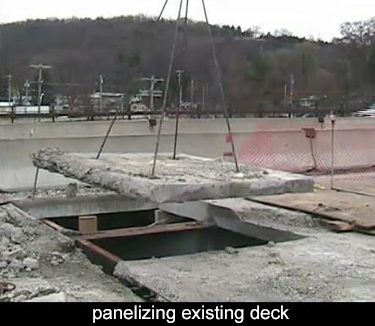The existing roadway has been closed. The traffic has been shifted to one side, and now the existing deck can be removed. That is being done by saw cutting it into panels. That's a very attractive option, because there are no shear connectors, so that these panels can be lifted right off the structural steel. Just below this photo, the north abutment has already been built to the underside of this bridge. Once this is removed, the north abutment can be completed. With this bridge removed, the South abutment can be constructed in one go to its full height, because the bridge will be gone.
I now have some video showing the saw cutting and the removal of the deck panels. Here you can see the traffic has been shifted. The on-ramp is being guided by barrels, but the construction area itself is protected by concrete barriers. The traffic is moving along very nicely, and there doesn't seem to be any backup or any hesitation.
The existing bridge deck is now being removed. There's a variety of activities going on. In the background, there's a hydraulic hammer breaking the concrete. It could be an approach slab or some kind of a wing wall. The two laborers are breaking concrete by hand. There is an expansion joint assembly at the end of the bridge and they need to break the concrete out around it so that that can be removed. In the foreground, you can see the concrete saw. It's really a very simple device. It's operated by one man, but it's very effective in cutting through the rebar in the deck and creating panels out of the deck slab.
 The slab has been cut into panels and now they're ready to lift out and dispose of the panels. They've made four holes in each panel, so that you can introduce a sling. Actually, they're introducing two slings in order to have 100% redundancy. You can see just behind the laborer, there's that very rough edge with exposed rebar. That had to be broken out by hand, but the rest of the bridge was cut into very neat panels. Of course, the saw cuts through the rebar as well as the concrete.
The slab has been cut into panels and now they're ready to lift out and dispose of the panels. They've made four holes in each panel, so that you can introduce a sling. Actually, they're introducing two slings in order to have 100% redundancy. You can see just behind the laborer, there's that very rough edge with exposed rebar. That had to be broken out by hand, but the rest of the bridge was cut into very neat panels. Of course, the saw cuts through the rebar as well as the concrete.
You can see this laborer has full protection. Obviously where the panels are being removed there's a danger of falling into that space, so he is protected against that. Now they're lifting out the first panel. Cutting the deck into panels was a very attractive solution for polishing this bridge, because there are no shear connectors, so that the slabs can be lifted right off the structural steel. Had there been sheer connectors, it would have been very difficult to use this approach. You probably would have demolished the slab in place.
Now, the crane is walking away with one of the panels. You can see it's traveling on these steel roadway plates. Because you've done all the saw cutting, you've certainly compromised that slab. You've cut through all the rebar, so that the rebar is no longer continuous and it was felt that you needed these steel roadway plates to help distribute the load of the crane.
I think if you would have had a spare set of slings, somebody could have been installing those slings while the crane was driving away and disposing of that slab. Probably could have saved a little time in this operation. The area to be demolished here was three lanes wide and a little over 400 feet long. It took two and a half weeks to remove all of the slab.